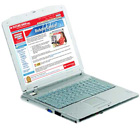Notebook computers have emerged as one of computing's must-haves, not only for busy business people, but also for students, creative people, and anyone who wants to have ready access to a powerful tool that helps them be their most productive, creative, and effective.
The available configurations are as diverse as the needs of those who use them. Some need a powerful system with a trim profile that can be discreetly carried and quietly used in meetings or lectures. Others need a larger screen and enough power to multimedia work. Still others need a system that can serve as a desktop, but can also work just as well when the user needs to get out of the office, even remaining wirelessly linked to the network.
Notebooks let you do practically anything you would do on a desktop, and many of the same considerations will be important when choosing your notebook. This guide will help explain some of the available features and help you decide on which ones you actually need.
 One Size Does Not Fit All One Size Does Not Fit All
Not all users are the same, so why should all notebooks would be designed the same way? Some users opt for portability over power or feature set, while others demand a robust, versatile system to take the place of a conventional desktop, and aren't too concerned about inches or ounces. Still others are on the fence, wanting a smaller system with all of the features they need.
Generally, notebooks are divided into three general size classifications. Subcompact, or 'thin and light' notebooks offer the greatest portability, with the lowest profile and overall dimensions and lightest weight.
The next size up still gives users great portability, but will feature a larger screen and, in many cases, a larger keyboard.
Up from here, you'll find 'desktop replacement' notebook systems that feature even larger screens and nearly full-sized keyboards. These systems are intended to serve as a more portable version of a standard desktop system. They will also typically be more expandable and versatile that smaller systems.
Another notable addition to this list is convertible notebooks with a swiveling and/or detachable tablet/display. For data entry, these systems can use a conventional QWERTY keyboard, or if you'd prefer, the LCD screen itself, via a stylus. If you find yourself in a situation where typing or mousing just doesn't cut it, you can simply swivel the display around, close it over the keyboard, and write or draw on the tablet like a piece of paper. This is especially help when drawing a quick diagram to explain an idea. Software converts your input into text or graphics that can be manipulated like any other data.
Screen Options
Screen size is another important consideration. Smaller screens are better suited to those who want the smallest package possible for portability. Typically, notebook screens will range from 12" to 17", when measured diagonally from corner to corner.
The larger screens are better for anyone who works with graphics or video. They're also handy for those who want to view on-screen documents side by side, or simply want them to be a little easier to read. A larger screen is also nice if you plan on using your notebook as a portable DVD player. so you can see more of the action, with less squinting.
Look for a display with a widescreen format, not only for a portable home theatre experience, but maximum versatility for working with spreadsheets, multimedia, and more.
Notebooks have liquid crystal display (LCD) screens, most of which are capable of showing fine detail and vibrant colours. Most now offer TFT (thin film transistor) LCD screens, which provide better image quality and a wider viewing angle.
Processors and Memory
The size of your notebook and display won't mean much if your system doesn't have the memory or processing power to do what you want it to do.
Processing speed is an important consideration if you plan on putting your notebook through its paces. If you you do graphics or video work, play games, or use other multimedia applications, you will want to get as much processing speed as you can afford. Even for more basic users, its good to not limit yourself by purchasing a notebook that barely meets your needs today.
The Intel® CeleronTM is a basic, low-cost processor that is well suited to general computing, basic office productivity software, and most online use. The Pentium® 4 can handle them with aplomb. Intel's specialized notebook processor, the Pentium M, also knows as Intel® CentrinoTM mobile technology, is a very capable unit in its own right and is optimized for mobile use, with particular emphasis on extending battery life.
For next-generation computing needs, watch for AMD's Athlon 64. Built on the Athlon XP foundation, the AMD64 platform offer 64-bit processing and HyperTransportTM technology. These provide real-world benefits today, such as lightning-fast processing and fewer data bottlenecks, plus ensures your system will be ready for future operating systems and applications that are optimized for 64-bit computing. New to AMD's lineup is the AMD TurionTM processor which integrates the AMD 64's 64-bit capabilities and advantages with much longer battery life.
As for RAM (Random Access Memory), the standard is currently 512MB. This was once considered a lot, but new, more sophisticated applications are always demanding more. You may want to consider a notebook with upgradeable RAM if you plan on constant application upgrades, which can often slow a system down. Notebooks will be limited in how much memory they can handle, so be sure to look for the maximum RAM capacity, not just how much is currently installed.
� |